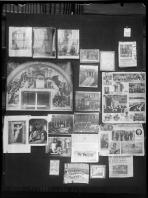Eucharistic variations
After the radical, often exuberant, sometimes ironic eclecticism and synchronism of the images in panels 77 & 78, Warburg, here in the left-side of the panel, signals a return to Renaissance "balance" and the Christian humanist ideal of "inversion" (whereby pagan images, motifs are 'transformed,' 'saved' or 'redeemed' for use in the Renaissance and beyond). Dominating these, at least in terms of size, is Raphael's 1511 Mass of Bolsena (#2) from the Vatican's Stanza d'Eliodoro, which depicts the miracle at Bolsena in 1263, when the host began to bleed just when a priest, who was skeptical of the real presence, celebrated the Eucharist. This supernatural event is mediated, firstly, by Raphael's formal mastery and the calm, anachronistic presence in the fresco of his contemporaries who contemplate the miracle at a distance, and, secondly, by the juxtaposition of the fresco with Giotto's Spes [Hope] (#3), from a grisaille in the Scrovegni Chapel in Padua, and Botticelli's Last Communion of St. Jerome (#4). If the former, as Schoell-Glass suggests, invokes Warburg's beloved nympha, the latter, I would add, also indicates a crucial translatio or transference of meaning. All these images map "paganism in the Church," as does the presence of three images of the Cathedra Petri [Chair of St. Peter], the Pope's throne in St. Peter's.
